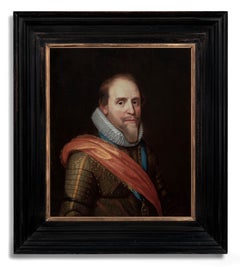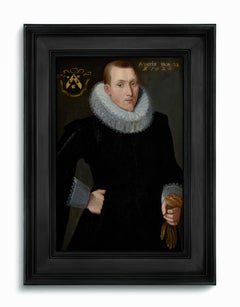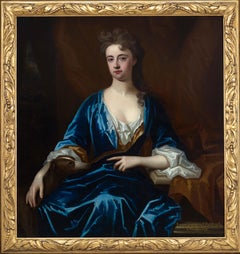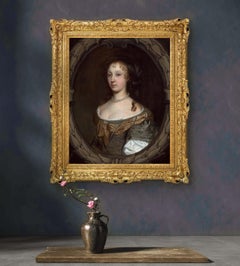Want more images or videos?
Request additional images or videos from the seller
1 of 12
16th Century Florentine SchoolPortrait of a Gentleman in a Black Doublet Holding a Medallion c.1575/80circa 1575
circa 1575
$30,583.75List Price
About the Item
- Creator:16th Century Florentine School (1500 - 1599, Italian)
- Creation Year:circa 1575
- Dimensions:Height: 41.34 in (105 cm)Width: 35.83 in (91 cm)Depth: 3.55 in (9 cm)
- Medium:
- Movement & Style:
- Period:
- Condition:This item has passed a strict quality and condition assessment by a professional conservator prior to going on sale.
- Gallery Location:London, GB
- Reference Number:1stDibs: LU1199110329822
About the Seller
5.0
Vetted Professional Seller
Every seller passes strict standards for authenticity and reliability
Established in 1998
1stDibs seller since 2019
45 sales on 1stDibs
Typical response time: 1 hour
Authenticity Guarantee
In the unlikely event there’s an issue with an item’s authenticity, contact us within 1 year for a full refund. DetailsMoney-Back Guarantee
If your item is not as described, is damaged in transit, or does not arrive, contact us within 7 days for a full refund. Details24-Hour Cancellation
You have a 24-hour grace period in which to reconsider your purchase, with no questions asked.Vetted Professional Sellers
Our world-class sellers must adhere to strict standards for service and quality, maintaining the integrity of our listings.Price-Match Guarantee
If you find that a seller listed the same item for a lower price elsewhere, we’ll match it.Trusted Global Delivery
Our best-in-class carrier network provides specialized shipping options worldwide, including custom delivery.You May Also Like
1920 Cesare Ciani Credited Italian Macchiaiolo Portrait Painting
By Cesare Ciani
Located in Roma, IT
1920 Cesare Ciani Credited Italian Macchiaiolo Portrait Painting
A beautiful, intense painting attributed to the great Macchiaioli painter Cesare Ciani.
It depicts with rare realism...
Category
1920s Old Masters Portrait Paintings
Materials
Oil, Wood Panel
$1,541
H 17.72 in W 13 in D 0.2 in
Spanish school. Secretary of Pope Pius V, abbot of Husillos, bishop of Córdoba.
Located in Firenze, IT
Portrait of Francisco de Reynoso y Baeza.
Secretary of Pope Pius V, abbot of Husillos and bishop of Córdoba. Francisci de Reynoso.
Early 17th century.
Small-format portrait from the late Renaissance period.
Spanish school.
Size: Cm 19 x Cm 13.5
Oil on wooden panel.
On the back the fine tablet is strengthened (already in ancient times) by a sheet of parchment.
About 1600-1610.
As often in Mannerist / Late Renaissance portraits, the image of the character is accompanied by the writing that runs at the top, adding a celebratory, historicising touch to the effigy. Let's bring back the sentence here:
DON FRANCISCO DE REINOSO. CAMARERO SECRETO IESCALCO PIO QUINTO OBISCOPO CORDOBA. 68 (? O 7?)
(1534, Autillo de Campos, Spain - 1601, Córdoba)
Francisco de Reynoso was a Spanish cleric, chief chamberlain, and secretary to Pope Pius V, abbot of Husillos, and bishop of Córdoba.
He was the fourth of eleven children. His father was the seventh Lord of Autillo de Campos, and his mother was Juana de Baeza y de las Casas, daughter of Manuel de Baeza, a lawyer of the Royal Council and at the Court of Valladolid.
Francisco de Reynoso was deeply devoted to the Virgin Mary and showed a strong inclination toward religion and piety from an early age.
He studied Latin, arts, and theology at the University of Salamanca.
In 1562, he traveled to Rome with his brothers Pedro and Luis.
In January 1566, following the death of Pope Pius IV, Cardinal Antonio Michele Ghislieri was elected pope, becoming Pius V. From this period until Ghislieri's death in 1572, Francisco de Reynoso served as his chief chamberlain and secretary.
After Pope Pius V died, Francisco de Reynoso returned to Spain and lived for several years in the city of Palencia, where his brother Manuel was a canon.
He supported the Society of Jesus when it was established in Palencia, providing alms to the school's clergy and funding chairs of Letters and Theology at his own expense, as well as donating a significant number of books.
During the brief outbreak of the Black Plague...
Category
17th Century Old Masters Portrait Paintings
Materials
Parchment Paper, Oil, Wood Panel
$1,522 Sale Price
20% Off
Free Shipping
H 7.49 in W 5.32 in
19th century Oil portrait of a Hungarian Rabbi
Located in Woodbury, CT
This 19th-century oil on panel portrait depicts a Hungarian Rabbi, characterized by his traditional attire and solemn expression. The Rabbi is portrayed with a long, white beard and ...
Category
1890s Old Masters Figurative Paintings
Materials
Oil, Wood Panel
Portrait of an Old Bearded Man
Located in Stockholm, SE
We are pleased to offer a captivating portrait, most likely painted in the late 18th century, attributed to an artist within the circle of Christian Wilhelm Ernst Dietrich. This oil ...
Category
Late 18th Century Old Masters Portrait Paintings
Materials
Oil, Wood Panel
Lucretia, by Giacomo Raibolini Francia. Detto il Francia. Oil on panel, framed
Located in New York, NY
Giacomo used to paint with his brother Giulio, identifying their works with the monogram «I I». The strong influence of his father, Francesco, is undeniable in all his works, althoug...
Category
16th Century Old Masters Figurative Paintings
Materials
Oil, Wood Panel
$18,000
Free Shipping
H 25.6 in W 19.3 in D 1.19 in
Christ on the Cold Stone – After Jan Gossaert (Mabuse)
Located in Stockholm, SE
This striking devotional image, painted by a follower of Jan Gossaert, represents one of the most influential compositions of the Northern Renaissance: Christ on the Cold Stone, or C...
Category
16th Century Old Masters Figurative Paintings
Materials
Oil, Wood Panel
Portrait of an Elderly Man
Located in Stockholm, SE
This finely executed oil painting, attributed to the circle of Christian Wilhelm Ernst Dietrich, captures the contemplative expression of an elderly man, his gaze lowered in quiet re...
Category
Early 19th Century Old Masters Portrait Paintings
Materials
Oil, Wood Panel
Portrait of an Old Bearded Man With a Black Cap
Located in Stockholm, SE
We are pleased to offer a captivating portrait, most likely painted in the late 18th century, attributed to an artist within the circle of Christian Wilhelm Ernst Dietrich. This oil ...
Category
Late 18th Century Old Masters Portrait Paintings
Materials
Oil, Wood Panel
$2,854
Free Shipping
H 14.18 in W 11.82 in
Portrait of a lady in blue dress ”Countess of Peterborough”
Located in Stockholm, SE
This exquisite portrait, with its new attribution to Theodore Russel, is believed to depict Lady Penelope O'Brien, daughter of Barnabas O'Brien, the sixth Earl of Thomond, and wife of the Earl of Peterborough, whom she married in 1644. The painting thus belongs to a historically significant period, capturing the refined elegance of the time.
The portrait has a prestigious provenance from Elleholms Hofgård, a historic estate in Mörrums socken, Blekinge, Sweden. Elleholms Hofgård, whose two-story, timber-framed main building was constructed in 1730 and expanded in 1804, has changed ownership several times since the 17th century. The ancestors of the present owners acquired the estate in 1915, and from the 20th century until 2023, this painting was prominently displayed in the estate’s main building, making it an integral part of the estate’s history.
Theodore Russel, an English portrait artist born in 1614, studied under the renowned Sir Anthony van Dyck, whose influence can be seen in Russel’s meticulous style. Russel often painted on cabinet-sized panels, such as this one, which measures approximately 39 x 31 cm. This preference for panels is a notable characteristic that sets him apart from contemporary artists like Sir Peter Lely, who exclusively used canvas. The size of the panel is a key reason for the reattribution to Russel from Peter lely, as Lely never used panels for his works. This distinctive format, along with Russel’s characteristic style, strongly supports the new attribution.
Russel, the son of Nicasius Rousseel, a goldsmith and jeweler to James I and Charles I, refined his skills under the mentorship of his uncle, the famous portrait painter Cornelis Janssen. He also worked as an assistant and copyist for van Dyck, further honing his artistic style. This captivating portrait exemplifies Russel’s craftsmanship, reflecting the elegance of the period’s fashion and the artist's refined techniques.
oil on wood panel
with indistinct inscription Countess of Peter[...] upper left.
with inscription on the reverse: ”Countess of Peterborough. P. Lely 1670. S Beatty Picture Restorer [...] Warwick”.
unframed 39 x 31 cm = 15.35 x 12.2 inches
framed 52 x 41.5 cm = 20.47 x 16.34 inches
Condition:
The portrait has just been restored by a professional art conservator in Stockholm and is now in a very good condition. The colors are vivid, and the skin tones appear more natural than before. It is a very fine painting. The frame is newly made and included.
Provenance:
Elleholms Hofgård, Mörrums socken, Blekinge, Sweden **;
Stockholms Auktionsverk, Fine Art & Antiques Autumn...
Category
17th Century Old Masters Portrait Paintings
Materials
Oil, Wood Panel
$11,298
H 20.48 in W 16.34 in
Tri-Directional Portrait Commemorating the Russo-Turkish War
Located in New Orleans, LA
Austrian School
18th Century
Tri-Directional Portrait Commemorating the Russo-Turkish War
Oil on wooden strips
This extraordinary tri-directional portrait exemplifies the rare innovation known as a triscenorama, capturing a pivotal diplomatic moment through ingenious artistic technique. Employing triangularly cut wooden strips, this remarkable work simultaneously depicts three imperial figures central to the Russo-Turkish War of 1735-1739: Empress Anna Ivanovna Romanova of Russia when viewed directly, Holy Roman Emperor Charles VI from the left and Ottoman Sultan Mahmud I from the right, commemorating the Treaty of Nissa that concluded this significant European conflict.
The portrait utilizes an exceptionally rare optical technique that predates modern movable imaging technology. When observed from different angles, the painted triangular wooden strips create a transformative effect, revealing entirely different imperial portraits as the viewer shifts position. The precision required to execute such a work demonstrates remarkable technical mastery, as the artist had to conceptualize three distinct portraits as well as the meticulous arrangement of the panels. This sophisticated manipulation of perspective creates an interactive viewing experience considered revolutionary for its time.
Almost certainly created by an Austrian artist, this diplomatic artwork likely served as a commemorative piece marking the Treaty of Nissa, signed in September 1739. The treaty concluded Russia's ambitious campaign to secure access to the Black Sea while countering Ottoman raids in Ukraine and the Caucasus regions. Given its exceptional quality and historical significance, this portrait was possibly commissioned by Emperor Charles VI himself, potentially serving as a diplomatic gift to either Empress Anna or Sultan Mahmud I during the treaty negotiations.
Under Empress Anna's leadership, Russia sought to counter devastating raids from Ottoman allies, particularly the Crimean Tatars...
Category
18th Century Old Masters Portrait Paintings
Materials
Wood, Oil, Wood Panel
$148,500
H 18.88 in W 15.88 in D 2 in
More From This Seller
View AllDutch Old Master Portrait of Maurits, Prince of Orange-Nassau, Oil on Panel
Located in London, GB
In 1607, the Delft city council decided to commission a portrait of Stadholder Maurits of Nassau for the town hall, with Michiel van Mierevelt as the chosen artist due to the passing...
Category
17th Century Old Masters Portrait Paintings
Materials
Oil, Wood Panel
Portrait of a Gentleman, Doublet & White Ruff, Gloves Inscribed 1624, on panel
By Frans Pourbus the Younger
Located in London, GB
Titan Fine Art presents this exquisite oil on panel portrait depicting a handsome young gentleman in an exuberant black damask doublet. The pose, with one hand holding gloves and the other akimbo, was one that was well-established for gentleman of the upper echelons of society by the time this work was painted. The principle governing portraits at this time was the recording and defining in visual terms of the position of a sitter in society. In addition to brilliant and complex symbols of luxury, they often contained many symbolic elements too; the inclusion of gloves was often used in portraits that celebrated a betrothal as in ancient times gloves were used to seal a marriage contract.
The extraordinary costume of a black shimmering doublet, the brilliant white reticella ruff, and the cuffs edged with lace were immensely costly… this attire proclaims to every onlooker that this is a superior being. The rendering of the reticella lace ruff is exquisite and the artist has recorded the design that runs through the black damask fabric with meticulous attention to detail. The preservation of this black pigment is remarkable considering the age of the work. Black pigments are especially vulnerable to fade and wear over time partly due to environmental condition but also from unprofessional cleaning. This work is an exquisite example from the period.
According to the inscription in the upper right, the gentleman was in his 22nd year of age in 1624. The coat of arms, which is displayed without a crest, may be ‘blazoned’ in the language of heraldry, as: Sable on a Chevron between in chief two Roundels and in base a Billet [or possibly Square] Or three Martlets Sable. In plainer English this means a black (Sable) background, spanned by a gold (Or) chevron, above which are two golden solid circles (Roundels), and below which is a gold rectangle (Billet); on the chevron are three small black birds (Martlets). Martlets are a stylised form of heraldic bird, believed to be based on the swift, which are conventionally drawn with small tufts instead of feet. In Continental Europe it is also conventional for them to be drawn without beaks, as appears to be the case here. The birds in this instance also have a vaguely duck-like appearance.
Five families have been identified with very close armorial bearings to the one in our portrait. They are the (van) Houthem’s (of Brabant), the Prévinaire’s (of Flanders and Holland), and the Proveneer’s (of Liège) and it must be noted that the locations of these families also fit with the painting’s Flemish origins. However the French Grenières’s (of Île-de-France) and the Jallot’s (of Normandy) are the next closest matches and plausible matches, as Frans Pourbus had settled in Paris just a few years before our portrait was painted.
This painting has been assessed by a professional conservator prior to going on sale, and as thus, it can be hung and enjoyed immediately.
Frans Pourbus the Younger...
Category
17th Century Old Masters Portrait Paintings
Materials
Oil, Wood Panel
Portrait of Lady, Barbara Herbert, Countess of Pembroke c.1708, Large Painting
Located in London, GB
Portrait of Barbara Herbert, Countess of Pembroke c.1708
Charles d’Agar (1669-1723)
This magnificent large-scale portrait, presented by Titan Fine Art, depicts the British court of...
Category
17th Century Old Masters Portrait Paintings
Materials
Cotton Canvas, Oil
Portrait of a Lady in Green Dress & Pearl Jewellery c.1660 Painting John Wright
By John Michael Wright
Located in London, GB
In this exquisite work, painted around the time of the Great Fire of London in 1666, a beautiful young woman is wearing a green dress over a white chemise and a russet-coloured scarf...
Category
17th Century Old Masters Portrait Paintings
Materials
Canvas, Oil
Portrait of a Gentleman, David Erskine, 13th Laird of Dun, Wearing Armour c.1700
Located in London, GB
The gentleman in this exquisite oil on canvas portrait, presented by Titan Fine Art, is shown with the grandiloquence characteristic of the English School of painting. He is portray...
Category
17th Century Old Masters Portrait Paintings
Materials
Oil, Canvas
Portrait of a Gentleman in Grey Coat & White Cravat, Oil on canvas Painting
Located in London, GB
This exquisite work, presented by Titan Fine Art, is by the notable artist Hans Hysing, who was a noteworthy painter in England; it is significant in its q...
Category
18th Century Old Masters Portrait Paintings
Materials
Canvas, Oil
Recently Viewed
View AllMore Ways To Browse
Portrait 16th Century Oil
Medallion Paintings
Titan Fine Art
Portrait Of Young Man
Dark Portrait
Male Vintage Portraits
19th Century Portrait Young Man
Portrait Of Child
Antique Royal Portraits
17th And 18th Century Portraits
Male Portrait Paintings
1920 Oil Portraits
Antique Family Portraits
Russia Portrait
Gentleman Oil Portrait
French School 18th Century
Gilt Framed Woman Portrait Oil Paintings
Impressionist Portrait Of A Young Girl



